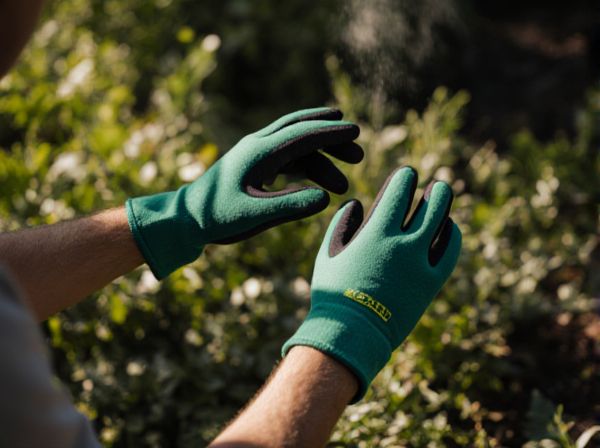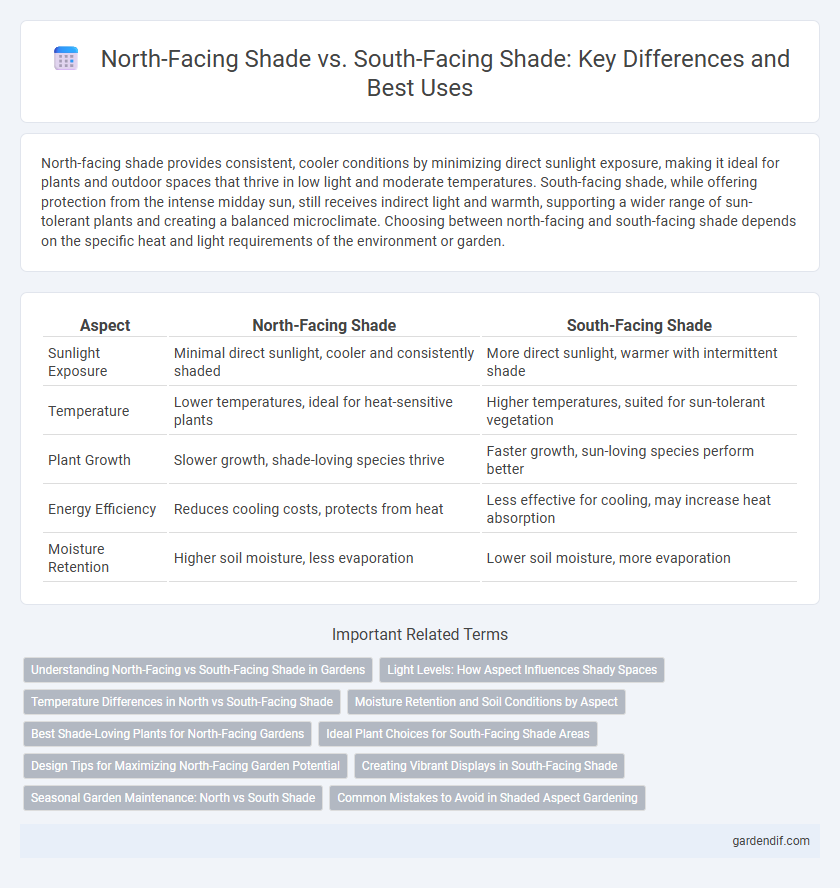
north-facing shade vs south-facing shade Illustration
North-facing shade provides consistent, cooler conditions by minimizing direct sunlight exposure, making it ideal for plants and outdoor spaces that thrive in low light and moderate temperatures. South-facing shade, while offering protection from the intense midday sun, still receives indirect light and warmth, supporting a wider range of sun-tolerant plants and creating a balanced microclimate. Choosing between north-facing and south-facing shade depends on the specific heat and light requirements of the environment or garden.
Table of Comparison
| Aspect | North-Facing Shade | South-Facing Shade |
|---|---|---|
| Sunlight Exposure | Minimal direct sunlight, cooler and consistently shaded | More direct sunlight, warmer with intermittent shade |
| Temperature | Lower temperatures, ideal for heat-sensitive plants | Higher temperatures, suited for sun-tolerant vegetation |
| Plant Growth | Slower growth, shade-loving species thrive | Faster growth, sun-loving species perform better |
| Energy Efficiency | Reduces cooling costs, protects from heat | Less effective for cooling, may increase heat absorption |
| Moisture Retention | Higher soil moisture, less evaporation | Lower soil moisture, more evaporation |
Understanding North-Facing vs South-Facing Shade in Gardens
North-facing shade in gardens provides cooler, more consistent shade throughout the day, ideal for shade-loving plants such as ferns and hostas that thrive in lower light and moisture-rich environments. South-facing shade experiences more intense, variable sunlight exposure, creating dappled or partial shade beneficial for plants requiring moderate sun, like hydrangeas and azaleas. Understanding these distinct light and temperature conditions allows gardeners to strategically place plants for optimal growth and health.
Light Levels: How Aspect Influences Shady Spaces
North-facing shade typically offers consistent, indirect light that stays cool and soft throughout the day, creating ideal conditions for shade-loving plants and comfortable outdoor spaces. South-facing shade experiences more variable light levels with bright, filtered sunlight during the winter months and stronger shadows in summer, affecting plant growth and temperature regulation. Understanding these light differences helps optimize garden design, plant selection, and energy efficiency in shaded areas.
Temperature Differences in North vs South-Facing Shade
North-facing shade tends to be cooler due to limited direct sunlight exposure, maintaining lower temperatures throughout the day. South-facing shade, receiving more intense and prolonged sunlight, experiences relatively higher temperatures even in shaded areas. Temperature differences between these orientations can influence plant growth, outdoor comfort, and energy consumption in buildings.
Moisture Retention and Soil Conditions by Aspect
North-facing shade typically retains higher moisture levels due to reduced direct sunlight, promoting cooler and damp soil conditions ideal for moisture-loving plants. South-facing shade experiences more sunlight exposure, resulting in drier soils with faster evaporation rates that favor drought-tolerant species. Understanding the aspect-driven differences in soil moisture retention is crucial for optimizing plant selection and irrigation strategies in shaded landscapes.
Best Shade-Loving Plants for North-Facing Gardens
North-facing gardens typically receive limited direct sunlight, creating cool and consistently shaded conditions ideal for shade-loving plants like hostas, ferns, and astilbes. These plants thrive in low light by developing efficient photosynthesis mechanisms and moisture retention adaptations. Choosing species such as hellebores, lungworts, and Japanese forest grass ensures robust growth and vibrant foliage in north-facing shaded areas.
Ideal Plant Choices for South-Facing Shade Areas
South-facing shade areas benefit from plants that thrive in dappled sunlight and moderate heat, such as hostas, ferns, and astilbes. These plants possess adaptive traits like broad leaves and efficient shade tolerance, making them suitable for the intense reflected light typical of south-facing locations. Incorporating shade-loving perennials with moisture-retentive soil conditions optimizes growth and enhances landscape aesthetics in these environments.
Design Tips for Maximizing North-Facing Garden Potential
North-facing gardens benefit from shade-tolerant plant selections such as ferns, hostas, and astilbes that thrive in indirect light. Incorporating reflective surfaces like light-colored walls or mirrors enhances natural brightness and offsets limited sun exposure. Utilizing vertical gardening and layered planting creates depth while optimizing space in shaded areas.
Creating Vibrant Displays in South-Facing Shade
South-facing shade offers a unique environment with indirect sunlight that enhances the growth of vibrant foliage plants and colorful flowers. Utilizing heat-tolerant and shade-loving species such as impatiens, begonias, and ferns creates lush, dynamic displays that thrive in the filtered light typical of south-facing areas. Strategic layering and varied textures amplify visual interest, maximizing the aesthetic potential of south-facing shaded spaces.
Seasonal Garden Maintenance: North vs South Shade
North-facing shade tends to maintain cooler, moister conditions that require less frequent watering and careful selection of shade-tolerant plants during seasonal garden maintenance. South-facing shade often experiences warmer temperatures and drier soil, necessitating more regular irrigation and pruning to manage sun exposure and plant health throughout the growing season. Gardeners must adjust fertilization schedules and mulching techniques to accommodate the distinct microclimates created by north versus south-facing shade.
Common Mistakes to Avoid in Shaded Aspect Gardening
Common mistakes in north-facing shade gardening include overwatering due to poor evaporation and neglecting plants that tolerate low light levels, leading to poor growth and fungal diseases. In south-facing shaded areas, gardeners often underestimate the intensity of reflected heat, causing plant stress and sunburn despite the shade. Avoiding these errors by selecting shade-appropriate species and monitoring moisture levels improves garden health and plant resilience.
north-facing shade vs south-facing shade Infographic

 gardendif.com
gardendif.com